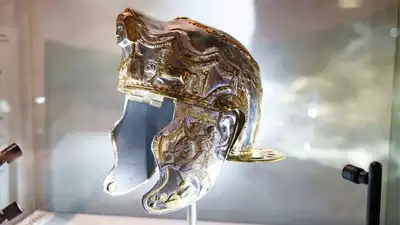What distinguishes this 2,000-year-old helmet from others?
The English countryside produced a historical gold mine twenty years ago in the shape of a little “rusty bucket.” The 2,000-year-old cavalry helmet that amateur archaeologist Ken Wallace discovered would turn out to be one of the most astounding discoveries of early Roman Britain.
The helmet—now referred to as the Hallaton Helmet—was found in Leicestershire, England, together with a cache of other Iron Age relics and money.

At first glance, it seemed ordinary, buried amid gold coins and pig bones, indicating that it had been placed at a local British shrine. But under the dirt and rust, the helmet’s real worth was hidden.
rusty bucket
The Hallaton Helmet dates to around 43 B.C.E. and is said to have belonged to a high-ranking Roman cavalry commander. Its elaborate pattern consists of thin silver and iron layers that are embellished with gold leaf. The helmet has wreaths, lions, the goddess Victory, and a depiction of a Briton cowering under the hooves of a Roman emperor’s horse. This particular design has caused researchers to disagree over how the Romans and Britons interacted during the Roman conquest of Britain.
The renovation took more than 20 years and was quite detailed. In its broken condition, experts from Leicester University and the British Museum carefully rebuilt the helmet. Donations helped fund the conservation efforts, and one major grant from the Heritage Lottery Fund enabled Leicester County Council to buy the helmet for public display.
In addition to reviving a piece of history, the restoration of the helmet raised significant issues for further study. The helmet’s existence and the way it was buried, according to Dr. Jeremy Hill of the British Museum, indicate that nearby Britons may have fought with the Romans. The conventional story of the Roman conquest as a clear-cut battle between the invaders and the local inhabitants is called into question by this viewpoint.
Some academics, on the other hand, believe that the helmet represents the intricate exchanges between the Roman conquerors and the captured Britons and is either a military trophy or a diplomatic gift. Whatever the helmet’s initial intent, its restoration has given spectators a physical link to the past and a window into the creativity and workmanship of a bygone period.
The Hallaton Helmet is now on display at the Harborough Museum, where it honours the durability of the Roman Empire in Britain as well as the artistry of ancient craftspeople. In addition to protecting an important archaeological discovery, restoration efforts have sparked a renewed interest in Roman Britain’s history and its influence on the area’s cultural legacy.
History is important to preserve, as shown by the helmet’s transformation from a rusted antique to a beautifully restored beauty. It emphasises the value of archaeological pursuits and the need for ongoing funding for them.







